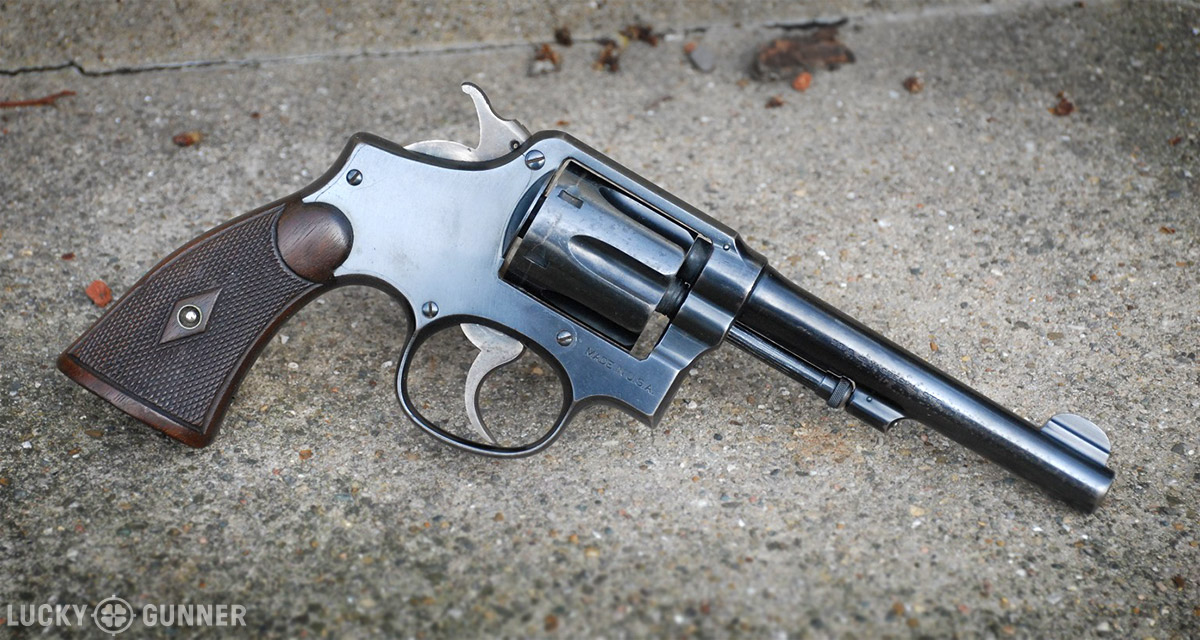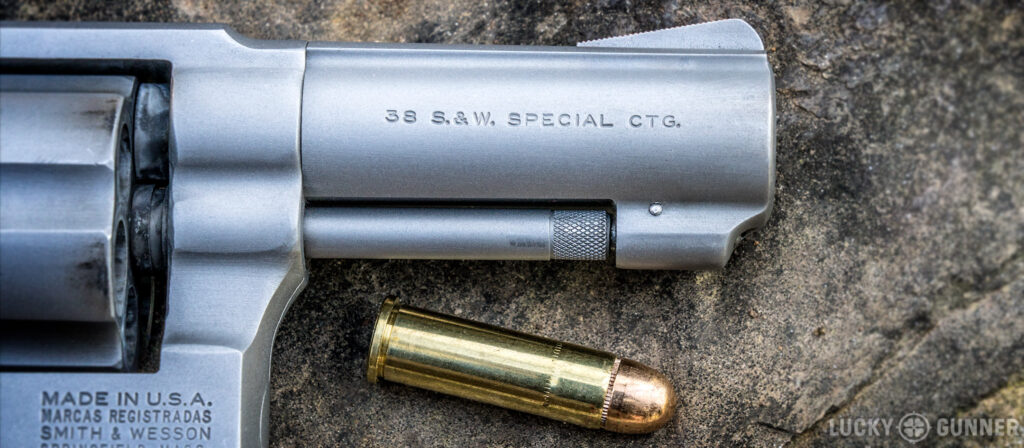Most stories begin at the beginning. To tell the story of the .38 Smith & Wesson Special cartridge, however, it’s necessary to go quite a ways back, before the beginning, back before metallic cartridge firearms entirely.
Certain bore diameters that are still with us today became standard back in the day when muzzleloading smoothbores were still measured in “gauge” or “bore”. Those numbers signified the number of round lead balls of that bore diameter it took to make a pound. The .72” caliber “12-bore” was, of course, popular among 18th Century frontstuffers and is still with us as a shotgun gauge. However, 50-, 60-, 100-, and 150-bore live on as well, as those work out to the bore diameters we all know today.
It’s the 100-bore size that became popular in Colt’s first revolving percussion pistol, the .36 caliber Paterson revolver. When the Republic of Texas Navy ordered 180 .36 Patersons, it represented Sam Colt’s first big martial sale. The bore size continued to be used in the Colt 1851 “Navy” revolvers that were common in the post-Civil War West and, eventually, was formalized in the first double-action revolver with a solid frame and swing-out cylinder to be general issue in the U.S. military, the Colt M1892.
The cartridge chambered in this revolver was known as the .38 Long Colt, and its big combat debut in the Spanish-American War was less than stellar. Smith & Wesson, who was working on a new revolver that would have been chambered for the service cartridge, immediately changed their plans.
The .38 Special is Born
The new medium-frame (known as the “K-frame” in Smith speak) revolver from S&W aped the swing-out cylinder and manual ejection of the Colt, causing it to be referred to as the “Hand Ejector” as opposed to the older top-break Smiths which automatically ejected the spent shells when broken open.
“The advertising literature of the day boasted that it launched a bullet hard enough to smash through eight and a half 7/8ths-inch pine boards, 125% as much as the competitor from Colt.”
Instead of chambering the new revolver in the .38 Long Colt, S&W developed a new cartridge of the same diameter but with the bullet weight upped from 150 to 158 grains and the powder charge likewise increased from 18 to 21½ grains of black powder. The resulting round, dubbed the .38 Smith & Wesson Special, boasted a serious performance increase. The advertising literature of the day boasted that it launched a bullet hard enough to smash through eight and a half 7/8ths-inch pine boards, 125% as much as the competitor from Colt. The cartridge was swiftly converted over to the new smokeless powder, albeit retaining the 158-grain lead round-nosed (LRN) projectile.

Perhaps in anticipation of future sales success, Smith dubbed the new K-frame Hand Ejector the “Military & Police”. Although nobody knew it when the first M&Ps hit store shelves in the closing year of the 19th Century, the most prolific service and defense handgun/cartridge combination of the next century had arrived. For most of the next eight decades, the medium-frame .38 Special Smith would be the iconic Good Guy gun.
The .38 Special in the 1900-1960s
Things got off to a slow start, however. The military fiddled with some ginormous Colt revolvers before adopting the M1911 pistol. The first several years of sales of the .38 M&P Smith consisted of about 20,000 .38 Special, including orders of a thousand guns apiece to the Army and Navy. Sales soon picked up, and the .38 Special 158-grain LRN eventually became a benchmark revolver cartridge for many years.
The first big variation on the .38 Special formula came almost three decades after the cartridge’s introduction. The Great Depression and Prohibition had given rise to the era of the motor bandit, and American gunmakers were pressured to deliver handguns that could defeat the heavy-gauge auto bodies and primitive bulletproof vests of the day. Colt souped up their .38 ACP into the .38 Super while Smith & Wesson decided to turbocharge their popular .38 Special.
The result was the .38/44 Heavy Duty, the numerical designator indicating that it was only intended to be fired in large-frame revolvers originally intended for the .44 Special round. It offered a claimed muzzle velocity of over 1100 feet per second. Since the cases were the same size as the regular .38 Special, it would be possible to fire them in a K-frame M&P, although that would not be advised. At best, it would lead to premature wear, and at worst, damage to the gun and shooter. It eventually led to the development of the .357 Magnum.
Around the same time period, heavy bullets were tried to increase the performance of the standard .38 Special against auto bodies. These 200-grain flat-point loadings were referred to by various manufacturers as “.38 Super Police” or “.38 Highway Patrol” loads. They stayed on the market for a while but never supplanted the basic 158-grain LRN.
The next big variation to the .38 Special happened in the 1950s. During WWII, the British military changed their issue revolver round from the original plain lead round nose to a metal-jacketed bullet for fear that the soft lead projectile might run afoul of the 1899 Hague Declaration prohibiting expanding bullets. Despite dabbling with some steel-jacketed ball, the standard US military .38 Special load remained the 158-grain LRN all through the war. After the war, the fledgling USAF, who issued .38 Special revolvers to aircrew and Security Police alike, decided to hedge their bets and shopped for a jacketed .38 issue round. The result was the 130-grain FMJ, which runs about fifty feet per second faster than the old 158-grain LRN. This is still a common load for sale at indoor ranges for air quality reasons and tends to print a little low out of fixed sight guns.
Things pretty much sailed along through the 50s and into the 60s, but big changes would come to self-defense ammo in the wake of the turbulent 60s and 70s.
The .38 Special 1970s-80s
In the early 70s, a new .38 Special loading made big waves as several police departments adopted it. The 158-grain lead semi-wadcutter hollow point (LSWCHP) loaded to +P pressures was probably first popularized by the St. Louis Police Department. Several other big cities followed: Albuquerque, Chicago, Dallas, Miami, to name a few. Then the Federal Bureau of Investigation hopped aboard, pretty much sealing the round’s reputation as “The FBI Load”.
“Expanding bullets were decried as ‘inhumane’ or ‘deadly’. In reaction to all the national talk about hollowpoints, public safety commissioner Reginald Eaves in my hometown of Atlanta had the APD issue low-velocity wadcutters, derided by the cops and some newspaper columnists as ‘Reggie Pellets’.”
Packing close to 200 feet per second more steam than the traditional 158-grain LRN and featuring an expanding hollowpoint bullet to boot, the 158gr +P LSWCHP developed a reputation for being a much more effective fight-stopper than the old lead round nose. Furthermore, the acceptance of this loading by big city PDs and the FBI helped speed the process of legitimizing expanding bullets for law enforcement and, by extension, for armed citizen use.
For those not around at the time, this was a very big deal. The media, never very savvy to firearms technical issues, was in full hue and cry against the “Dum-Dum” bullets, as they called them, misidentifying them with obsolete British rifle ammo produced at the Indian arsenal of the same name. Expanding bullets were decried as “inhumane” or “deadly”. In reaction to all the national talk about hollowpoints, public safety commissioner Reginald Eaves in my hometown of Atlanta had the APD issue low-velocity wadcutters, derided by the cops and some newspaper columnists as “Reggie Pellets”. Fortunately, they were soon withdrawn.
Other alternatives to the 158-grain LRN began popping up on the landscape in the search for improved terminal performance. A light 110-grain JHP loaded beyond the SAAMI +P threshold was popularized by the Treasury department and its umbrella agencies such as the BATF. This was the 110-grain +P+ “Treasury load” or “Q load”. The light bullet and high-pressure charge made for a fast loading that put wear and tear on guns in a hurry, with almost magnum levels of muzzle blast. Lore behind the 110-grain +P+ JHP is that the agency wanted .357 Magnum performance without the political stigma (at the time) of issuing .357 Magnum revolvers. Remember, the general public was still getting used to the idea of hollow points! The Treasury load was also used by the Border Patrol and California Highway Patrol.
As the 70s rolled into the 80s, the .38 Special continued to evolve as a defensive cartridge, but its days of dominance were also drawing to a close. Many departments had adopted the .357 Magnum, bad PR be damned. More importantly, the perception that the police were “outgunned” by the bad guys would lead to even bigger shifts in the .38 market.
But that’s for Part Two…
Be sure to check out our ballistic gelatin test to find out how some of these old favorite .38 Special loads perform compared to modern hollow point bullets.
